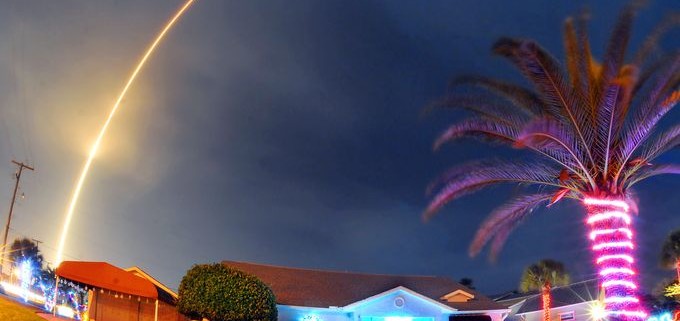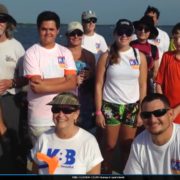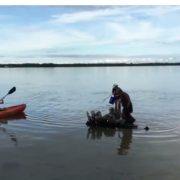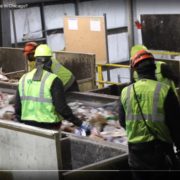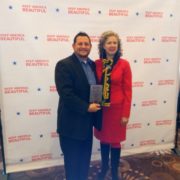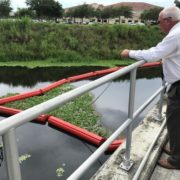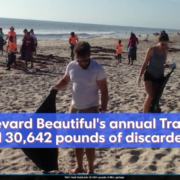SpaceX’s Falcon 9 Returns to Flight – Reusable Rocket
By James Dean, Florida Today
“The Falcon has landed.”
It may not top the Eagle’s 1969 moon landing with astronauts, but SpaceX’s confirmation Monday night that it had successfully landed a Falcon 9 rocket booster at Cape Canaveral Air Force Station could be remembered as a turning point in space history.
It marked the first time a large rocket has delivered spacecraft to orbit and returned to Earth intact, so that it could potentially fly again.
“Welcome back, baby,” SpaceX CEO Elon Musk said on Twitter.
He later told reporters the achievement was “a revolutionary moment.”
Musk and other space entrepreneurs see reusable rockets as the key to dramatically lowering the cost of access to space, which could enable many more missions and even make human exploration of Mars a more realistic goal.
“It really quite dramatically improves my confidence that a city on Mars is possible,” said Musk. “I mean, that’s what all of this is about.”
The 230-foot Falcon 9 blasted off from Launch Complex 40 at 8:29 p.m., rumbling aloft with 1.5 million pounds of thrust and a payload of 11 commercial satellites to begin its return to flight after a June 28 launch failure.
About two-and-a-half minutes later, the rocket’s 14-story first stage dropped away and began the first of three engine burns to guide itself back toward a concrete pad at SpaceX’s “Landing Complex 1” at the Cape, the former Launch Complex 13.
Observers along the Space Coast and beyond could see rocket engines fire like a torch in darkness as the booster descended from as high as 124 miles up and slowed its fall from hypersonic speed.
A tremendous “boom” could be heard shortly after the stage touched down a few miles down the coast from where it had lifted off. Even Musk, from a vantage point several miles away, thought the rocket was a goner.
It turned out the touchdown coincided with the sonic boom created by the rocket’s descent. Camera images showed the stage standing upright on four legs. The Falcon had landed.
A huge crowd of employees gathered at SpaceX’s headquarters in Hawthorne, California, were jubilant, erupting in cheers and chants of “USA!”
Cheers also rang out at Kennedy Space Center, where hundreds of people associated with Orbcomm Inc, whose 11 satellites were on top of the rocket’s upper stage and still headed to orbit, were gathered to watch.
The cheers continued as the satellites were deployed safely about 500 miles up, ensuring the mission was a success for the publicly traded provider of machine-to-machine communications, an industry sometimes referred to as the “Internet of Things.”
But after the landing, that primary mission was nearly an afterthought.
About a month ago, Blue Origin, the private space firm founded by Amazon.com CEO Jeff Bezos, also landed a booster after a test flight in Texas. It was a smaller stage that did not travel as fast and lofted a capsule only briefly into space before it fell back to the ground.
“This is just really a world of difference compared to other rockets,” said Musk. “It would be like having an aircraft that can be used many times, when all the other aircraft in the world can be used once.”
SpaceX twice earlier this year had attempted to land boosters on ships in the ocean, demonstrating an ability to precisely control the stages’ return from space. Both attempts hit their mark, but the boosters could not stay upright and crashed.
SpaceX decided it was time to return to land, as was always its long-term goal.
After the landing, plans called for SpaceX to “safe” the once-white rocket stage — visibly scorched from its engine firings during the flight back — by purging leftover propellant into a tanker, venting gasses and making any explosives inert.
A crane would then lift the stage onto a stand for the landing legs to be folded up or removed before being placed horizontally on a transporter and returned to a SpaceX hangar.
Musk said the stage likely will be test-fired at Kennedy Space Center’s pad 39A at some point to show it could be used again, but might be kept on the ground because of its historical significance.
After the spectacle of an orbital rocket landing, it remains to be seen if Falcon 9 rockets can be readied for flight again easily enough and often enough to fulfill the economic promise of reusability, which Bezos has called the “Holy Grail” of rocketry.
Musk thinks re-flying rockets will be “straightforward” and is no less certain of the technology’s importance to spaceflight.
“It’s all the difference in the world,” he said. “Absolutely fundamental.”



